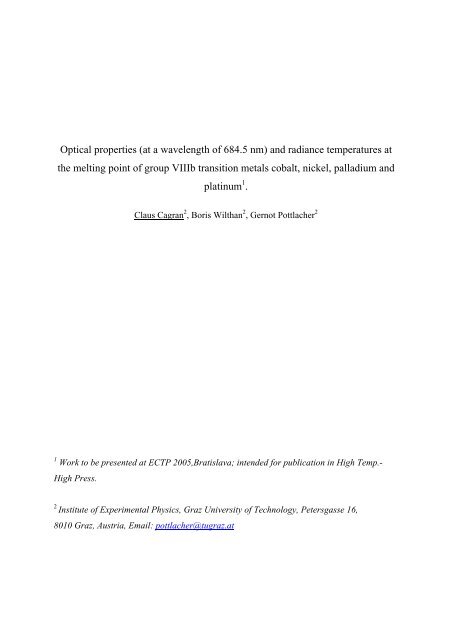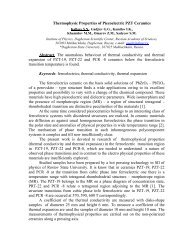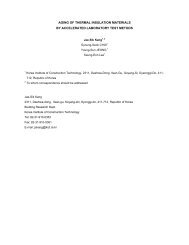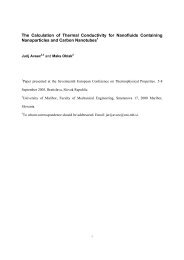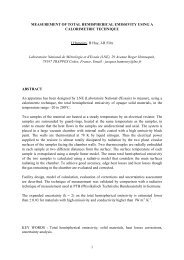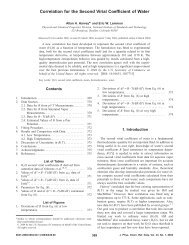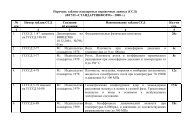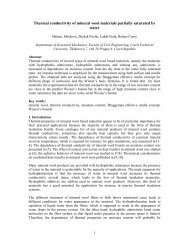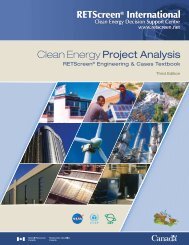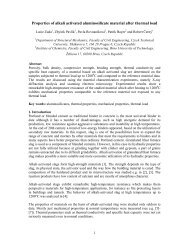Optical properties (at a wavelength of 684.5 nm) - thermophysics.ru
Optical properties (at a wavelength of 684.5 nm) - thermophysics.ru
Optical properties (at a wavelength of 684.5 nm) - thermophysics.ru
Create successful ePaper yourself
Turn your PDF publications into a flip-book with our unique Google optimized e-Paper software.
<strong>Optical</strong> <strong>properties</strong> (<strong>at</strong> a <strong>wavelength</strong> <strong>of</strong> <strong>684.5</strong> <strong>nm</strong>) and radiance temper<strong>at</strong>ures <strong>at</strong><br />
the melting point <strong>of</strong> group VIIIb transition metals cobalt, nickel, palladium and<br />
pl<strong>at</strong>inum 1 .<br />
Claus Cagran 2 , Boris Wilthan 2 , Gernot Pottlacher 2<br />
1 Work to be presented <strong>at</strong> ECTP 2005,Br<strong>at</strong>islava; intended for public<strong>at</strong>ion in High Temp.-<br />
High Press.<br />
2<br />
Institute <strong>of</strong> Experimental Physics, Graz University <strong>of</strong> Technology, Petersgasse 16,<br />
8010 Graz, Austria, Email: pottlacher@tugraz.<strong>at</strong>
ABSTRACT<br />
The optical constants (index <strong>of</strong> refraction n and extinction coefficient k) and normal spectral<br />
emissivity <strong>of</strong> liquid cobalt, nickel, palladium and pl<strong>at</strong>inum were measured by a Division-<strong>of</strong>-<br />
Amplitude-Photopolarimeter (DOAP) oper<strong>at</strong>ing <strong>at</strong> a <strong>wavelength</strong> <strong>of</strong> <strong>684.5</strong> <strong>nm</strong>. The polarimeter<br />
is part <strong>of</strong> a pulse-he<strong>at</strong>ing appar<strong>at</strong>us using resistive self-he<strong>at</strong>ing <strong>of</strong> conducting specimens from<br />
room temper<strong>at</strong>ure to the end <strong>of</strong> the liquid st<strong>at</strong>e in less than 50 µs. Temper<strong>at</strong>ure during this<br />
experiments (except for nickel) was simultaneously determined by a fast optical pyrometer<br />
oper<strong>at</strong>ing <strong>at</strong> a center <strong>wavelength</strong> <strong>of</strong> 650 <strong>nm</strong> utilizing Planck’s radi<strong>at</strong>ion law. Additionally,<br />
results for radiance temper<strong>at</strong>ures <strong>at</strong> melting <strong>at</strong> <strong>684.5</strong> <strong>nm</strong> calcul<strong>at</strong>ed from emissivity and the<br />
melting temper<strong>at</strong>ure are presented for all four m<strong>at</strong>erials. The melting-point emissivities<br />
(normal spectral) / radiance temper<strong>at</strong>ures <strong>at</strong> <strong>684.5</strong> <strong>nm</strong>, as determined by averaging several<br />
experimental results for each m<strong>at</strong>erial, are: 0.346 / 1623.1 K for cobalt, 0.365 / 1595.8 K for<br />
nickel, 0.360 / 1678.8 K for palladium, and 0.364 / 1858.9 K for pl<strong>at</strong>inum, respectively. The<br />
results for all determined optical <strong>properties</strong> are given as melting-point values as well as linear<br />
least-squares fits to the liquid st<strong>at</strong>e. Based on uncertainties arising from polarimetry,<br />
pyrometery and sample conditions, the combined uncertainty for emissivity and optical<br />
constants (with a coverage factor <strong>of</strong> k = 2) is estim<strong>at</strong>ed and reported.<br />
INTRODUCTION<br />
Ever since D<strong>ru</strong>de proposed his theory and a formula for the optical <strong>properties</strong> <strong>of</strong> metals based<br />
on free charge carriers in 1900 [D<strong>ru</strong>de 1900], lots <strong>of</strong> efforts have been taken to determine<br />
[i.e., Palik 1990] and interpret [e.g., Roberts 1955] the optical constants N = n – ik (N –<br />
complex index <strong>of</strong> refraction, n – (real or classical) index <strong>of</strong> refraction, k – extinction<br />
coefficient) <strong>of</strong> metals and metal surfaces.<br />
According to Palik 1990 (subpart 1) four general methods are used for obtaining experimental<br />
d<strong>at</strong>a from which optical constants can be deduced: the Kramers-Kronig method, the<br />
reflectance method, ellipsometry, and the use <strong>of</strong> electron-loss spectroscopy. Out <strong>of</strong> these four<br />
techniques, d<strong>at</strong>a obtained by the Kramers-Kronig method and electron-loss spectroscopy are<br />
found to be more accur<strong>at</strong>e than by the remaining two methods. Nevertheless, all four methods<br />
are not basically restricted to the solid st<strong>at</strong>e <strong>of</strong> the metals under investig<strong>at</strong>ion but<br />
measurements in the liquid st<strong>at</strong>e are <strong>of</strong>ten avoided or omitted (due to the high chemical<br />
2
eactivity <strong>of</strong> liquid metals and hence the arising ambiguities in d<strong>at</strong>a interpret<strong>at</strong>ion). Therefore,<br />
d<strong>at</strong>a for n and k in the liquid st<strong>at</strong>e are very sparse in liter<strong>at</strong>ure.<br />
A couple <strong>of</strong> years ago, an ellipsometric measurement device was added to the experimental<br />
pulse-he<strong>at</strong>ing setup <strong>at</strong> Graz University <strong>of</strong> Technology (TUG). The purpose <strong>of</strong> this<br />
ellipsometer was the determin<strong>at</strong>ion <strong>of</strong> normal spectral emissivity to increase the accuracy <strong>of</strong><br />
pyrometrical obtained temper<strong>at</strong>ures during pulse-he<strong>at</strong>ing experiments on metals and alloys.<br />
Pulse-he<strong>at</strong>ing uses the passage <strong>of</strong> a large current pulse over a conducting sample (cylindrical<br />
or rectangular shaped wires) which are resistively self-he<strong>at</strong>ed <strong>at</strong> r<strong>at</strong>es up to 10 8 K/s. As a<br />
consequence, typical experimental dur<strong>at</strong>ions are about 50 µs <strong>at</strong> this high he<strong>at</strong>ing r<strong>at</strong>es. During<br />
this short period, samples can be he<strong>at</strong>ed from room temper<strong>at</strong>ure up to the end <strong>of</strong> the stable<br />
liquid phase (boiling point), which is one <strong>of</strong> the main advantages <strong>of</strong> this containerless<br />
technique.<br />
Due to the time-scale used throughout pulse-he<strong>at</strong>ing experiments, the used ellipsometer<br />
cannot use any rot<strong>at</strong>ion devices or moving parts. Therefore, a µs-Division-<strong>of</strong>-Amplitude-<br />
Photopolarimeter (DOAP) is used whose basic concepts, utilizing the Stokes formalism for<br />
polarized light, have first been pointed out by Azzam (1982) and l<strong>at</strong>er on adopted and applied<br />
by Krishnan (1992).<br />
Unlike the other four methods mentioned above, the DOAP enables the time resolved<br />
measurement <strong>of</strong> optical <strong>properties</strong> n and k during such pulse-he<strong>at</strong>ing experiments in the liquid<br />
st<strong>at</strong>e. The anticip<strong>at</strong>ed (normal spectral) emissivity can be calcul<strong>at</strong>ed in a second step as a byproduct<br />
from the optical constants.<br />
Over the last few years a wide variety <strong>of</strong> pure metals have been investig<strong>at</strong>ed concerning<br />
emissivity <strong>at</strong> melting and its behaviour in the liquid phase and the results have been partially<br />
published elsewhere [Cagran 2002, Cagran 2004].<br />
EXPERIMENTAL<br />
As mentioned in the introduction, the optical constants n and k as well as normal spectral<br />
emissivity are obtained with a DOAP system which itself is a part <strong>of</strong> a resistive pulse-he<strong>at</strong>ing<br />
appar<strong>at</strong>us <strong>at</strong> the Institute <strong>of</strong> Experimental Physics (IEP-TUG). More detailed inform<strong>at</strong>ion as<br />
well as a schem<strong>at</strong>ic drawing <strong>of</strong> the system can be found in [Seifter 2002, Cagran 2002].<br />
The basic principle <strong>of</strong> this device is to detect (time resolved) the change in polariz<strong>at</strong>ion <strong>of</strong> an<br />
initially polarized laser beam <strong>of</strong> known polariz<strong>at</strong>ion upon refection from a sample surface.<br />
The Stokes formalism <strong>of</strong> polarized light uses the division <strong>of</strong> the overall light intensity into<br />
3
four independent components (thus the name <strong>of</strong> the DOAP) which are recorded separ<strong>at</strong>ely.<br />
Out <strong>of</strong> these four so-called ‘Stokes parameters’, the st<strong>at</strong>e <strong>of</strong> polariz<strong>at</strong>ion after reflection can be<br />
evalu<strong>at</strong>ed with help <strong>of</strong> the knowledge <strong>of</strong> the initial polariz<strong>at</strong>ion. In a second step, n and k can<br />
be rel<strong>at</strong>ed to the polariz<strong>at</strong>ion <strong>of</strong> the reflected light and the spectral normal reflectivity, R ⊥ , <strong>of</strong><br />
the sample m<strong>at</strong>erial is obtained with<br />
2 2<br />
( n2<br />
− n1<br />
) + k2<br />
2 2<br />
( n + n ) + k<br />
R⊥ =<br />
(1)<br />
2<br />
1<br />
2<br />
where n 2 and k 2 are the optical constants <strong>of</strong> the m<strong>at</strong>erial under investig<strong>at</strong>ion and n 1 is the<br />
refractive index <strong>of</strong> the ambient <strong>at</strong>mosphere (air or nitrogen).<br />
In turn, normal spectral emissivity ε for opaque m<strong>at</strong>erials can be deduced from reflectivity by:<br />
2 2<br />
( n2 − n1<br />
) + k2<br />
4n1n2<br />
=<br />
2 2<br />
2 2<br />
( n + n ) + k ( n + n ) + k<br />
ε 1−<br />
R = 1−<br />
(2)<br />
⊥<br />
=<br />
⊥<br />
2<br />
1<br />
In our experiment, the measurement <strong>of</strong> the optical <strong>properties</strong> and emissivity is limited to<br />
normal incidence and to the laser <strong>wavelength</strong> used within the DOAP system, nominally<br />
λ = <strong>684.5</strong> <strong>nm</strong>. The laser <strong>wavelength</strong> <strong>of</strong> the DOAP was chosen from commercially available<br />
solid st<strong>at</strong>e laser diodes to m<strong>at</strong>ch the <strong>wavelength</strong> <strong>of</strong> the main pyrometer (λ = 650 <strong>nm</strong>) as close<br />
as possible. Although the emissivity measurement improves the pyrometric temper<strong>at</strong>ure, a not<br />
yet exactly specified uncertainty is implied by the difference in <strong>wavelength</strong>s.<br />
More in-depth details on the DOAP and the d<strong>at</strong>a evalu<strong>at</strong>ion can are shown in Seifter (2002)<br />
and in Cagran (2003).<br />
Additionally, radiance temper<strong>at</strong>ures, T r , for all m<strong>at</strong>erials under investig<strong>at</strong>ions can be<br />
calcul<strong>at</strong>ed with knowledge <strong>of</strong> emissivity, ε, its <strong>wavelength</strong>, λ (in our case <strong>684.5</strong> <strong>nm</strong>), and the<br />
melting temper<strong>at</strong>ure, T m , <strong>of</strong> the m<strong>at</strong>erial with:<br />
2<br />
c2<br />
1<br />
T<br />
r<br />
= ⋅<br />
(3)<br />
λ ⎛ ⎛ c ⎞ ⎞<br />
⎜<br />
2<br />
exp − ⎟<br />
⎜<br />
⎜<br />
⎟ 1<br />
⎝ λ ⋅Tm<br />
⎠ ⎟<br />
ln⎜1+<br />
⎟<br />
⎜ ε ⎟<br />
⎜<br />
⎟<br />
⎝<br />
⎠<br />
c 2 deontes Planck’s second radi<strong>at</strong>ion constant, and its value is c 2 = 1.4388 mK [Henning<br />
1977].<br />
2<br />
1<br />
2<br />
RESULTS AND DISCUSSION<br />
Wired shaped metal samples (cylindrical cross-section <strong>of</strong> nominally ∅ = 0.5 mm and an<br />
average length <strong>of</strong> about 45 mm) have been used for all four investig<strong>at</strong>ed group VIIIb metals.<br />
4
Some <strong>of</strong> the samples have been tre<strong>at</strong>ed with high grade abrasive paper and acetone prior to<br />
the experiment to remove thin surface layers (i.e. oxides, nitrides, etc.) and organic<br />
substances, e.g., f<strong>at</strong>. Further m<strong>at</strong>erial specific<strong>at</strong>ions can be found in Tab. 1.<br />
The surface tre<strong>at</strong>ment prior to the experiments and the initial surface st<strong>ru</strong>cture <strong>of</strong> the sample<br />
m<strong>at</strong>erial (which is mainly a result <strong>of</strong> the wire drawing) can drastically change the solid st<strong>at</strong>e<br />
optical <strong>properties</strong>/emissivity <strong>of</strong> the sample m<strong>at</strong>erial as ε, n, and k are in our experiments<br />
domin<strong>at</strong>ed by the surface. Therefore, one can almost produce any solid st<strong>at</strong>e value for these<br />
<strong>properties</strong> by changing the surface (roughness, st<strong>ru</strong>cture). This effect vanishes not until<br />
melting is reached and smoothening <strong>of</strong> the surface due to surface tension gener<strong>at</strong>es<br />
reproducible conditions for each m<strong>at</strong>erial 1 . As a result, the DOAP is primarily intended for<br />
measurements <strong>at</strong> melting and in the liquid st<strong>at</strong>e; reported values for the solid st<strong>at</strong>e are shown<br />
for completion and to outline the overall behaviour <strong>of</strong> ε, n, and k before T m .<br />
All results presented in figures in the following are mean values <strong>of</strong> several independent<br />
measurements (the exact number <strong>of</strong> experiments for each metal is st<strong>at</strong>ed in the corresponding<br />
section).<br />
Cobalt: Experimental results (average <strong>of</strong> 6 independent measurements) for optical <strong>properties</strong> n<br />
and k and normal spectral emissivity for solid and liquid cobalt are presented in Fig.1. The<br />
values <strong>of</strong> n, k, and ε <strong>at</strong> melting and linear least-squares fits for the liquid st<strong>at</strong>e as well as the<br />
radiance temper<strong>at</strong>ure calcul<strong>at</strong>ed according to Eq.(3) can be found in Tab. 2 and Tab. 3.<br />
1 To determine reproducible solid st<strong>at</strong>e values, the m<strong>at</strong>erial under investig<strong>at</strong>ion has to undergo special tre<strong>at</strong>ments<br />
(tempering under inert gas (or vacuum) <strong>at</strong> different temper<strong>at</strong>ures for some hours) and special measurement<br />
conditions have to be used (vacuum chamber or non-reactive inert gas <strong>at</strong>mosphere). As such procedures can not<br />
be applied to each sample <strong>at</strong> TUG and solid st<strong>at</strong>e values are not <strong>of</strong> primary interest, reported results are restricted<br />
to liquid st<strong>at</strong>e d<strong>at</strong>a only.<br />
5
normal spectral emissivity<br />
<strong>at</strong> <strong>684.5</strong> <strong>nm</strong><br />
optical constants n and k<br />
<strong>at</strong> <strong>684.5</strong> <strong>nm</strong><br />
0.525<br />
0.500<br />
0.475<br />
0.450<br />
0.425<br />
0.400<br />
0.375<br />
0.350<br />
0.325<br />
0.300<br />
0.275<br />
800 1000 1200 1400 1600 1800 2000 2200 2400 2600<br />
radiance temper<strong>at</strong>ure <strong>at</strong> 650 <strong>nm</strong>, K<br />
5.25<br />
5.00<br />
4.75<br />
4.50<br />
4.25<br />
4.00<br />
3.75<br />
k<br />
3.50<br />
3.25<br />
3.00<br />
2.75<br />
2.50<br />
2.25<br />
2.00<br />
n<br />
1.75<br />
800 1000 1200 1400 1600 1800 2000 2200 2400 2600<br />
radiance temper<strong>at</strong>ure <strong>at</strong> 650 <strong>nm</strong>, K<br />
a<br />
b<br />
Figure 1: Normal spectral emissivity (a) and optical <strong>properties</strong> n and k (b) <strong>at</strong> <strong>684.5</strong> <strong>nm</strong> <strong>of</strong> cobalt <strong>at</strong><br />
melting and in the liquid st<strong>at</strong>e versus radiance temper<strong>at</strong>ure. (a): open circles: emissivity d<strong>at</strong>a <strong>of</strong> this<br />
work (average <strong>of</strong> 6 independent measurements); solid line: linear least-squares fit to the liquid st<strong>at</strong>e;<br />
full up-triangle: liter<strong>at</strong>ure d<strong>at</strong>a <strong>of</strong> [Kaschnitz 1998a] interpol<strong>at</strong>ed for <strong>684.5</strong> <strong>nm</strong>. (b): solid squares:<br />
index <strong>of</strong> refraction, n, d<strong>at</strong>a <strong>of</strong> this work; open down-triangles: extinction coefficient, k, d<strong>at</strong>a <strong>of</strong> this<br />
work; dashed lines: linear least-squares fits to the solid st<strong>at</strong>e.<br />
The emissivity value <strong>at</strong> melting observed within the recent measurements is in good<br />
agreement with the liter<strong>at</strong>ure d<strong>at</strong>a published by Kaschnitz (1998a). Figure 1a exhibits the<br />
typical ε drop <strong>at</strong> melting due to smoothening <strong>of</strong> the surface (as described in the preceding<br />
section). No liter<strong>at</strong>ure d<strong>at</strong>a for comparison have been found for n and k <strong>of</strong> cobalt. All three<br />
<strong>properties</strong> show a slight increase throughout the liquid st<strong>at</strong>e.<br />
Nickel: Experimental results (average <strong>of</strong> 6 independent measurements) for optical <strong>properties</strong> n<br />
and k and normal spectral emissivity for solid and liquid nickel are presented in Fig.2. The<br />
6
values <strong>of</strong> n, k, and ε <strong>at</strong> melting and linear least-squares fits for the liquid st<strong>at</strong>e as well as the<br />
radiance temper<strong>at</strong>ure calcul<strong>at</strong>ed according to Eq.(3) can be found in Tab. 2 and Tab. 3.<br />
Note: As the radiance temper<strong>at</strong>ure <strong>of</strong> nickel almost equals the onset temper<strong>at</strong>ure <strong>of</strong> the<br />
pyrometer <strong>at</strong> λ = 650 <strong>nm</strong>, measurements have been carried out using another pyrometer<br />
oper<strong>at</strong>ing <strong>at</strong> 1570 <strong>nm</strong>. Since plotting optical <strong>properties</strong> and emissivity <strong>at</strong> <strong>684.5</strong> <strong>nm</strong> versus<br />
radiance temper<strong>at</strong>ures obtained <strong>at</strong> a completely different <strong>wavelength</strong> is not significant, values<br />
for nickel are shown versus temper<strong>at</strong>ure assuming a constant emissivity from melting<br />
throughout the liquid st<strong>at</strong>e (emissivity in liquid st<strong>at</strong>e / emissivity <strong>at</strong> melting = ε/ε m = 1). This<br />
assumption can be supported by the emissivity results in Fig. 2a.<br />
0.525<br />
0.500<br />
normal spectral emissivity<br />
<strong>at</strong> <strong>684.5</strong> <strong>nm</strong><br />
optical constants n and k<br />
<strong>at</strong> <strong>684.5</strong> <strong>nm</strong><br />
0.475<br />
0.450<br />
0.425<br />
0.400<br />
0.375<br />
0.350<br />
0.325<br />
1200 1400 1600 1800 2000 2200 2400<br />
temper<strong>at</strong>ure (assuming ε/ε m<br />
=1), K<br />
4.50<br />
4.25<br />
4.00<br />
3.75<br />
3.50<br />
3.25<br />
k<br />
3.00<br />
2.75<br />
2.50<br />
2.25<br />
2.00<br />
n<br />
1.75<br />
1200 1400 1600 1800 2000 2200 2400<br />
temper<strong>at</strong>ure (assuming ε/ε m<br />
=1), K<br />
a<br />
b<br />
Figure 2: Normal spectral emissivity (a) and optical <strong>properties</strong> n and k (b) <strong>at</strong> <strong>684.5</strong> <strong>nm</strong> <strong>of</strong> nickel <strong>at</strong><br />
melting and in the liquid st<strong>at</strong>e versus temper<strong>at</strong>ure (assuming a constant emissivity, ε/ε m =1, throughout<br />
the liquid st<strong>at</strong>e). (a): open circles: emissivity d<strong>at</strong>a <strong>of</strong> this work (average <strong>of</strong> 6 independent<br />
measurements); solid line: linear least-squares fit to the liquid st<strong>at</strong>e; solid up-triangle: liter<strong>at</strong>ure d<strong>at</strong>a <strong>of</strong><br />
[Kaschnitz 1998b] interpol<strong>at</strong>ed for <strong>684.5</strong> <strong>nm</strong>. (b): solid squares: index <strong>of</strong> refraction, n, d<strong>at</strong>a <strong>of</strong> this<br />
work; open down-triangles: extinction coefficient, k, d<strong>at</strong>a <strong>of</strong> this work; open square/solid down<br />
7
triangle: liter<strong>at</strong>ure d<strong>at</strong>a <strong>of</strong> n/k for the solid st<strong>at</strong>e <strong>of</strong> nickel <strong>at</strong> λ = 688.8 <strong>nm</strong> taken from [Palik 1990];<br />
dashed lines: linear least-squares fits to the solid st<strong>at</strong>e.<br />
The emissivity value <strong>at</strong> melting (Fig. 2a) observed within the recent measurements is again in<br />
good agreement with the liter<strong>at</strong>ure d<strong>at</strong>a published by Kaschnitz (1998b), whereas n and k<br />
show an interesting contradiction: the solid st<strong>at</strong>e values <strong>of</strong> n are (within the st<strong>at</strong>ed<br />
uncertainties) in good agreement with the value reported by Palik (1990) which does not hold<br />
for k. The interesting fact is th<strong>at</strong> as all reported <strong>properties</strong> change <strong>at</strong> melting, k in the liquid<br />
st<strong>at</strong>e compares quite good to the solid st<strong>at</strong>e value from Palik (1990). This altern<strong>at</strong>ing<br />
behaviour <strong>of</strong> n and k is believed to result from the already mentioned solid st<strong>at</strong>e surface<br />
st<strong>ru</strong>cture. For liquid nickel, the two optical constants show a slight decrease throughout the<br />
liquid st<strong>at</strong>e whereas emissivity increases slightly.<br />
Palladium: Experimental results (average <strong>of</strong> 6 independent measurements) for optical<br />
<strong>properties</strong> n and k and normal spectral emissivity for solid and liquid palladium are presented<br />
in Fig.3. The values <strong>of</strong> n, k, and ε <strong>at</strong> melting and linear least-squares fits for the liquid st<strong>at</strong>e as<br />
well as the radiance temper<strong>at</strong>ure calcul<strong>at</strong>ed according to Eq.(3) can be found in Tab. 2 and<br />
Tab. 3. Recently obtained thermophysical <strong>properties</strong> <strong>of</strong> solid and liquid palladium can be<br />
found in a corresponding article [Cagran 2005].<br />
8
normal spectral emissivity<br />
<strong>at</strong> <strong>684.5</strong> <strong>nm</strong><br />
optical constants n and k<br />
<strong>at</strong> <strong>684.5</strong> <strong>nm</strong><br />
0.525<br />
0.500<br />
0.475<br />
0.450<br />
0.425<br />
0.400<br />
0.375<br />
0.350<br />
0.325<br />
1200 1400 1600 1800 2000 2200 2400 2600 2800 3000 3200<br />
radiance temper<strong>at</strong>ure <strong>at</strong> 650 <strong>nm</strong>, K<br />
4.50<br />
4.25<br />
4.00<br />
3.75<br />
3.50<br />
3.25<br />
3.00<br />
2.75<br />
2.50<br />
k b<br />
2.25<br />
2.00<br />
n<br />
1200 1400 1600 1800 2000 2200 2400 2600 2800 3000 3200<br />
radiance temper<strong>at</strong>ure <strong>at</strong> 650 <strong>nm</strong>, K<br />
a<br />
Figure 3: Normal spectral emissivity (a) and optical <strong>properties</strong> n and k (b) <strong>at</strong> <strong>684.5</strong> <strong>nm</strong> <strong>of</strong> palladium <strong>at</strong><br />
melting and in the liquid st<strong>at</strong>e versus radiance temper<strong>at</strong>ure. (a): open circles: emissivity d<strong>at</strong>a <strong>of</strong> this<br />
work (average <strong>of</strong> 6 independent measurements); solid line: linear least-squares fit to the liquid st<strong>at</strong>e;<br />
full up-triangle: liter<strong>at</strong>ure d<strong>at</strong>a <strong>of</strong> [McClure 1999] interpol<strong>at</strong>ed for <strong>684.5</strong> <strong>nm</strong>. (b): solid squares: index<br />
<strong>of</strong> refraction, n, d<strong>at</strong>a <strong>of</strong> this work; open down-triangles: extinction coefficient, k, d<strong>at</strong>a <strong>of</strong> this work;<br />
dashed lines: linear least-squares fits to the solid st<strong>at</strong>e.<br />
The emissivity value <strong>at</strong> melting (Fig. 3a) observed within the recent measurements is once<br />
again in good agreement with the liter<strong>at</strong>ure d<strong>at</strong>a published by McClure (1999). As for cobalt,<br />
no liter<strong>at</strong>ure d<strong>at</strong>a for comparison have been found for n and k <strong>of</strong> palladium. The optical<br />
constants <strong>of</strong> palladium decrease whereas emissivity shows an increase during the liquid st<strong>at</strong>e.<br />
9
Pl<strong>at</strong>inum: Experimental results (average <strong>of</strong> 7 independent measurements) for optical<br />
<strong>properties</strong> n and k and normal spectral emissivity for solid and liquid pl<strong>at</strong>inum are presented<br />
in Fig.4. The values <strong>of</strong> n, k, and ε <strong>at</strong> melting and linear least-squares fits for the liquid st<strong>at</strong>e as<br />
well as the radiance temper<strong>at</strong>ure calcul<strong>at</strong>ed according to Eq.(3) can be found in Tab. 2 and<br />
normal spectral emissivity<br />
<strong>at</strong> <strong>684.5</strong> <strong>nm</strong><br />
optical constants n and k<br />
<strong>at</strong> <strong>684.5</strong> <strong>nm</strong><br />
0.39<br />
0.38<br />
0.37<br />
0.36<br />
0.35<br />
0.34<br />
0.33<br />
a<br />
0.32<br />
0.31<br />
0.30<br />
0.29<br />
0.28<br />
1400 1600 1800 2000 2200 2400 2600<br />
radiance temper<strong>at</strong>ure <strong>at</strong> 650 <strong>nm</strong>, K<br />
4.6<br />
4.4<br />
4.2<br />
4.0<br />
k<br />
3.8<br />
3.6<br />
3.4<br />
3.2<br />
b<br />
3.0<br />
2.8<br />
n<br />
2.6<br />
2.4<br />
2.2<br />
1400 1600 1800 2000 2200 2400 2600<br />
radiance temper<strong>at</strong>ure <strong>at</strong> 650 <strong>nm</strong>, K<br />
Figure 4: Normal spectral emissivity (a) and optical <strong>properties</strong> n and k (b) <strong>at</strong> <strong>684.5</strong> <strong>nm</strong> <strong>of</strong> pl<strong>at</strong>inum <strong>at</strong><br />
melting and in the liquid st<strong>at</strong>e versus radiance temper<strong>at</strong>ure. (a): open circles: emissivity d<strong>at</strong>a <strong>of</strong> this<br />
work (average <strong>of</strong> 6 independent measurements); solid line: linear least-squares fit to the liquid st<strong>at</strong>e;<br />
solid up-triangle: liter<strong>at</strong>ure d<strong>at</strong>a <strong>of</strong> [McClure 1999] interpol<strong>at</strong>ed for <strong>684.5</strong> <strong>nm</strong>; solid diamond: solid<br />
st<strong>at</strong>e liter<strong>at</strong>ure value extrapol<strong>at</strong>ed to melting taken from [Righini, 1980]. (b): solid squares: index <strong>of</strong><br />
refraction, n, d<strong>at</strong>a <strong>of</strong> this work; open down-triangles: extinction coefficient, k, d<strong>at</strong>a <strong>of</strong> this work; open<br />
square/solid down triangle: liter<strong>at</strong>ure d<strong>at</strong>a <strong>of</strong> n/k for the solid st<strong>at</strong>e <strong>of</strong> pl<strong>at</strong>inum <strong>at</strong> λ = 688.8 <strong>nm</strong> taken<br />
from [Palik 1990]; dashed lines: linear least-squares fits to the solid st<strong>at</strong>e.<br />
As can be seen from Figure 4a, pl<strong>at</strong>inum exhibits a different emissivity behaviour <strong>at</strong> melting<br />
compared to the other three m<strong>at</strong>erials: ε <strong>of</strong> pl<strong>at</strong>inum does not drop but suddenly increases <strong>at</strong><br />
the melting transition. This is caused by the good processability <strong>of</strong> pl<strong>at</strong>inum: drawn wires<br />
10
already have a perfectly smooth, shiny and most notably reproducible surface. Therefore,<br />
results obtained with the DOAP for the solid st<strong>at</strong>e are <strong>of</strong> equal quality as for the liquid st<strong>at</strong>e.<br />
Figure 4a reports the recently obtained emissivity results for pl<strong>at</strong>inum and both ε <strong>at</strong> the onset<br />
and after melting shows a good agreement with respective liter<strong>at</strong>ure d<strong>at</strong>a, Righini (1980) for<br />
the solid and McClure (1999) for the liquid. By abrading the pl<strong>at</strong>inum wires prior to the<br />
experiment emissivity in the solid can be drastically increased resulting in the experimental<br />
signals observed for the other three presented m<strong>at</strong>erials (higher emissivity in solid, drop <strong>at</strong><br />
melting). Nevertheless, as shown earlier for silver [Cagran 2003], the observed emissivity<br />
value and behaviour in the liquid is independent from the initial surface roughness.<br />
The different optical behaviour is also noticeable in the results for n and k as both show<br />
opposite trends upon melting. The refractive index increases (as with the other three<br />
investig<strong>at</strong>ed m<strong>at</strong>erials) but the extinction coefficient drops <strong>at</strong> T m . A comparison <strong>of</strong> the recently<br />
obtained solid st<strong>at</strong>e values regarding n and k shows a decent agreement with d<strong>at</strong>a published by<br />
Palik (1990) for pure pl<strong>at</strong>inum.<br />
For liquid pl<strong>at</strong>inum, an increase during the liquid st<strong>at</strong>e can be observed for all three<br />
investig<strong>at</strong>ed optical <strong>properties</strong>.<br />
Radiance temper<strong>at</strong>ures: To complete the set <strong>of</strong> optical <strong>properties</strong>, radiance temper<strong>at</strong>ures <strong>at</strong><br />
melting (<strong>at</strong> <strong>684.5</strong> <strong>nm</strong>) have been calcul<strong>at</strong>ed for all four m<strong>at</strong>erials according to Eq. 3. The<br />
individual results can be found in Tab. 2. No comparison <strong>of</strong> these radiance temper<strong>at</strong>ures with<br />
liter<strong>at</strong>ure d<strong>at</strong>a is provided as the measurement <strong>wavelength</strong> is not very common and no<br />
significant d<strong>at</strong>a are available. Nevertheless, as emissivity is in good agreement with liter<strong>at</strong>ure<br />
d<strong>at</strong>a, radiance temper<strong>at</strong>ures are also expected to be accur<strong>at</strong>e.<br />
UNCERTAINTIES<br />
An in-depth analysis <strong>of</strong> the uncertainty according to GUM (Guide to the expression <strong>of</strong><br />
Uncertainty in Measurement) [GUM 1999] for all feasible thermophysical <strong>properties</strong> is<br />
currently under development for the pulse-he<strong>at</strong>ing system used <strong>at</strong> TUG. These results will be<br />
incorpor<strong>at</strong>ed and published as soon as the analysis is completely finished. Meanwhile, the up<br />
to now used estim<strong>at</strong>ion <strong>of</strong> uncertainties has to be applied to the recent measurements which<br />
already incorpor<strong>at</strong>es expanded rel<strong>at</strong>ive uncertainties with a coverage factor <strong>of</strong> k = 2, as<br />
demanded by the concept <strong>of</strong> GUM. This recent estim<strong>at</strong>ion is based on the reproducibility and<br />
sc<strong>at</strong>ter <strong>of</strong> the measurements. Typically, the signal-to-noise r<strong>at</strong>io <strong>of</strong> a single experiment does<br />
11
not exceed ± 6 %. By averaging several different measurements to minimize the noise <strong>of</strong> the<br />
emissivity signals and applying a linear least-squares fit to the liquid phase behaviour <strong>of</strong><br />
normal spectral emissivity, the uncertainty can be reduced up to a factor <strong>of</strong> 2, thus one yields<br />
an uncertainty <strong>of</strong> ± 3 %. With respect to GUM and k=2, the uncertainty for normal spectral<br />
emissivity is given with ± 6 % for all m<strong>at</strong>erials with the exception <strong>of</strong> cobalt for which a<br />
uncertainty <strong>of</strong> ± 8 % (due to a weaker signal/noise r<strong>at</strong>io) should be given.<br />
A similar argument<strong>at</strong>ion is used when estim<strong>at</strong>ing the uncertainty <strong>of</strong> optical constants n and k<br />
and as a result an uncertainty <strong>of</strong> ± 6 % (± 8 % for cobalt) is estim<strong>at</strong>ed for both optical<br />
constants.<br />
CONCLUSIONS<br />
<strong>Optical</strong> <strong>properties</strong> measurements using a µs-DOAP on liquid cobalt, nickel, palladium, and<br />
pl<strong>at</strong>inum are presented within the recent work. The results for refractive index n, extinction<br />
coefficient k, normal spectral emissivity ε and radiance temper<strong>at</strong>ure <strong>at</strong> melting T r,m (all<br />
<strong>properties</strong> <strong>at</strong> <strong>684.5</strong> <strong>nm</strong>) are given in graphs as well as in tables for all investig<strong>at</strong>ed m<strong>at</strong>erials.<br />
From comparison <strong>of</strong> these d<strong>at</strong>a with liter<strong>at</strong>ure values, it can be seen th<strong>at</strong> the DOAP is also<br />
capable <strong>of</strong> determining the optical constants <strong>of</strong> liquid metals.<br />
All four m<strong>at</strong>erials exhibit an increase in normal spectral emissivity throughout the liquid st<strong>at</strong>e<br />
and thus fit seamlessly into c<strong>at</strong>egoriz<strong>at</strong>ion <strong>of</strong> m<strong>at</strong>erials with respect to their liquid st<strong>at</strong>e<br />
behaviour <strong>of</strong> ε as already published earlier in [Cagran 2002].<br />
The results for optical constants in the liquid st<strong>at</strong>e are a novelty, as liter<strong>at</strong>ure d<strong>at</strong>a are even<br />
sparse for solid m<strong>at</strong>erials but almost no published d<strong>at</strong>a exist for the liquid phase. As a future<br />
outlook it can be thought <strong>of</strong> adding d<strong>at</strong>a <strong>of</strong> optical constants to the standard set <strong>of</strong> available<br />
optical d<strong>at</strong>a determined <strong>at</strong> TUG.<br />
ACKNOWLEDGEMENTS<br />
The present work is partially supported by the Austrian ‘Fonds zur Foerde<strong>ru</strong>ng der<br />
wissenschaftlichen Forschung (FWF)’, Vienna, Grant 15055.<br />
12
TABLES<br />
Table 1: Summary <strong>of</strong> m<strong>at</strong>erial inform<strong>at</strong>ion for cobalt, nickel, palladium, and pl<strong>at</strong>inum specimens<br />
M<strong>at</strong>erial Supplier Purity Tre<strong>at</strong>ment Lot #<br />
Cobalt (Co) Alfa Aesar 99.995% n/a 06079<br />
Nickel (Ni) Advent Research M<strong>at</strong>erials 99.98% annealed Gi1136<br />
Palladium (Pa) Alfa Aesar 99.9% n/a F28J28<br />
Pl<strong>at</strong>inum (Pt) Advent Research M<strong>at</strong>erials 99.99+% annealed Gi1800<br />
Table 2: Summary <strong>of</strong> normal spectral emissivity results <strong>at</strong> <strong>684.5</strong> <strong>nm</strong> and radiance temper<strong>at</strong>ures for<br />
liquid cobalt, nickel, palladium, and pl<strong>at</strong>inum.<br />
T m : melting temper<strong>at</strong>ures taken from [Bedford 1996]; ε(T m ): normal spectral emissivity <strong>at</strong> T m ; T r,m :<br />
radiance temper<strong>at</strong>ures <strong>at</strong> melting (<strong>at</strong> <strong>684.5</strong> <strong>nm</strong>); ε(T): linear fit for emissivity in the liquid st<strong>at</strong>e; ΔT:<br />
nominal temper<strong>at</strong>ure range <strong>of</strong> validity <strong>of</strong> ε(T).<br />
Note: all temper<strong>at</strong>ures for ε(T) and ΔT are radiance temper<strong>at</strong>ures <strong>at</strong> 650 <strong>nm</strong> except for nickel<br />
(indic<strong>at</strong>ed by * , see text).<br />
M<strong>at</strong>erial T m [K] ε(T m ) T r,m [K] ε(T) ΔT [K]<br />
Cobalt (Co) 1768.0 0.346 1623.1 0.333 + 8.275×10 -6·T r 1630 < T r < 2650<br />
Nickel (Ni) 1728.0 0.365 1595.8 0.345 + 1.145×10 -5·T * 1728 < T * < 2450<br />
Palladium (Pa) 1828.0 0.360 1678.8 0.306 + 3.226×10 -5·T r 1680 < T r < 3150<br />
Pl<strong>at</strong>inum (Pt) 2041.3 0.364 1858.9 0.339 + 1.326×10 -5·T r 1660 < T r < 2500<br />
Table 3: Summary <strong>of</strong> refractive index and extinction coefficient results <strong>at</strong> <strong>684.5</strong> <strong>nm</strong> for liquid cobalt,<br />
nickel, palladium, and pl<strong>at</strong>inum.<br />
n(T m ): refractive index <strong>at</strong> T m ; n(T): linear fit for n in the liquid st<strong>at</strong>e; k(T m ): extinction coefficient <strong>at</strong> T m ;<br />
k(T): linear fit for k in the liquid st<strong>at</strong>e; ΔT: nominal temper<strong>at</strong>ure range <strong>of</strong> validity <strong>of</strong> ε(T).<br />
Note: all temper<strong>at</strong>ures for ε(T) and ΔT are radiance temper<strong>at</strong>ures <strong>at</strong> 650 <strong>nm</strong> except for nickel<br />
(indic<strong>at</strong>ed by * , see text).<br />
M<strong>at</strong>erial n(T m ) n(T) k(T m ) k(T) ΔT [K]<br />
Cobalt (Co) 3.126 2.631 + 3.030×10 -4·T r 4.130 3.999 + 8.021×10 -5·T r 1630 < T r < 2650<br />
Nickel (Ni) 2.949 3.202 - 1.465×10 -4· T * 4.029 4.230 - 1.166×10 -4·T * 1728 < T * < 2450<br />
Palladium (Pa) 2.793 2.934 - 8.347×10 -5·T r 4.104 4.810 - 4.188×10 -4·T r 1680 < T r < 3150<br />
Pl<strong>at</strong>inum (Pt) 2.881 1.567 + 7.070×10 -4·T r 4.044 3.717 + 1.761×10 -4·T r 1660 < T r < 2500<br />
13
REFERENCES<br />
Azzam R M A, 1982 Opt. Acta 29, 685-689.<br />
Bedford R E, Bonnier G, Maas H, Pavese F, 1996 Metrologia 33, 133-154.<br />
Cagran C, B<strong>ru</strong>nner C, Seifter A, Pottlacher G, 2002 High Temp.-High Press. 34, 669-679.<br />
Cagran C, Pottlacher G, 2003, in Temper<strong>at</strong>ure: Its measurement and control in science and<br />
industry Ed. D C Ripple (Melville: AIP Conference Proceedings) pp. 765-770.<br />
Cagran C, Wilthan B, Pottlacher G, 2004 Normal Spectral Emissivities (<strong>at</strong> <strong>684.5</strong> NM) <strong>of</strong><br />
liquid Gold, Rhenium, Titanium and Vanadium, work presented <strong>at</strong> TEMPMEKO 2004 and<br />
accepted for public<strong>at</strong>ion in the TEMPMEKO 2004 proceedings.<br />
Cagran C, Pottlacher G, 2005, Palladium: normal spectral emissivity (<strong>at</strong> <strong>684.5</strong> <strong>nm</strong>) and<br />
thermophysical <strong>properties</strong> <strong>at</strong> the melting transition and in the liquid st<strong>at</strong>e, additional work<br />
to be presented <strong>at</strong> ECTP 2005, intended for public<strong>at</strong>ion in High Temp.-High Press.<br />
D<strong>ru</strong>de P, 1900 Physik. Z. 1, pp. 161.<br />
European co-oper<strong>at</strong>ion for Accredit<strong>at</strong>ion, 1999 Expression <strong>of</strong> the Uncertainty <strong>of</strong> Measurement<br />
in Calibr<strong>at</strong>ion EA-4/02, www.european-accredi<strong>at</strong>ion.org/pdf/ea-4-02ny.pdf.<br />
Henning F, 1977 Temper<strong>at</strong>urmessung (D) (Heidelberg: Springer), p. 131.<br />
Kaschnitz E, McClure J L, Cezairliyan A, 1998 High Temp.-High Press. 29, 103-111.<br />
Kaschnitz E, McClure J L, Cezairliyan A, 1998 Int. J. Thermophys. 19(6), 1637-1646.<br />
Krishnan S, 1992 J. Opt. Soc. Am. 9, 1615-1622.<br />
McClure J L, Cezairliyan A, Kaschnitz E, 1999 Int. J. Thermophys. 20(4), 1149-1161.<br />
Palik E D, Ed., 1990 Handbook <strong>of</strong> <strong>Optical</strong> Constants <strong>of</strong> Solids (Boston: Academic Press, Inc).<br />
Righini F, Rosso A, 1980 High Temp.-High Press. 12, 335-349.<br />
Roberts S, 1955 Phys. Rev. 100(6), 1667-1971.<br />
Seifter A, Sachsenh<strong>of</strong>er F, Pottlacher G, 2002 Int. J. Thermophys. 23(5), 1267-1280.<br />
14


